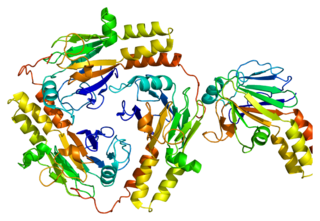
Mothers against decapentaplegic homolog 1 also known as SMAD family member 1 or SMAD1 is a protein that in humans is encoded by the SMAD1 gene.

Mothers against decapentaplegic homolog 9 also known as SMAD9, SMAD8, and MADH6 is a protein that in humans is encoded by the SMAD9 gene.

Cadherin EGF LAG seven-pass G-type receptor 2 is a protein that in humans is encoded by the CELSR2 gene.

C-C chemokine receptor type 4 is a protein that in humans is encoded by the CCR4 gene. CCR4 has also recently been designated CD194.

Transcription factor SOX-14 is a protein that in humans is encoded by the SOX14 gene.

T-cell leukemia homeobox protein 2 is a protein that in humans is encoded by the TLX2 gene.

Desert hedgehog, also Desert hedgehog homolog or Dhh, is a protein encoded by the DHH gene, and is a member of the hedgehog signaling pathway. The human homolog (DHH) is on chromosome band 12q13.1. The protein encoded by this gene is involved in cell signaling. The several mammalian variants of the Drosophila hedgehog gene have been named after the various species of hedgehog; the desert hedgehog is honored by this one. The gene is not specific to desert hedgehogs.

SOX1 is a gene that encodes a transcription factor with a HMG-box DNA-binding domain and functions primarily in neurogenesis. SOX1, SOX2 and SOX3, members of the SOX gene family, contain transcription factors related to SRY, the testis-determining factor.

Homeobox protein DBX2, also known as developing brain homeobox protein 2, is a protein that in humans is encoded by the DBX2 gene. DBX2 plays an important role in the development of the central nervous system, specifically in the development of the neural tube and brain. DBX2 is located on chromosome 12 and is approximately 36,000 base pairs long. DBX2 is predicted to enable DNA-binding transcription activity as well as being involved in the regulation of transcription by RNA polymerase II.

MAX dimerization protein 3 is a protein that in humans is encoded by the MXD3 gene located on Chromosome 5.

Solute carrier family 7, member 14 is a protein that in humans is encoded by the SLC7A14 gene.

Protein Wnt-8a is a protein that in humans is encoded by the WNT8A gene. Wnt8a may be involved in the development of early embryos as well as germ cell tumors.

Forkhead box Q1 is a protein that in humans is encoded by the FOXQ1 gene.

LIM homeobox 9 is a protein that in humans is encoded by the LHX9 gene.

Nucleolus and neural progenitor protein (NEPRO) is a protein that in humans is encoded by the NEPRO gene.
Neuronatin (Nnat) is a protein coding gene involved in mammalian brain development. It is located on Chromosome 20 in humans and is only expressed from the paternal allele in normal adults. It encodes the protein neuronatin, a proteolipid, that functions in the control of ion channels during brain development. Neuronatin begins the differentiation of pluripotent stem cells into cells with a neural fate by increasing their calcium levels. Neuronatin expression in neural tissues throughout the brain contributes to development of the nervous system. It is also expressed in several tissues outside of the brain. For example, expression in skin cells controls the differentiation of keratinocytes. Neuronatin expression functions not only in development, but other processes throughout the body. It also plays a direct and indirect role in diabetes. Increased expression in pancreatic islet beta cells causes the beta form of the protein to build an aggregate structure. This causes the cells to undergo apoptosis, thus leading to diabetes mellitus. Its effects on glycogen metabolism through the dephosphorylation and activation of the enzyme glycogen synthase may also play an indirect role in contributing to the disease. A different type of malformation in the gene also has the potential to cause a variety of cancers. Contained within the promoter region of the gene are three CpG islands. These imprint regions function in the regulation of gene expression through the process of cytosine methylation. The loss of methylation within these areas triggers an irregular cell growth, resulting in embryonic neoplasms.

Chromosome 21 open reading frame 91 is a protein that in humans is encoded by the C21orf91 gene.

DExH-box helicase 34 is a protein that in humans is encoded by the DHX34 gene.

Mab-21 like 1 is a protein that in humans is encoded by the MAB21L1 gene.

Mab-21 like 3 is a protein that in humans is encoded by the MAB21L3 gene.















